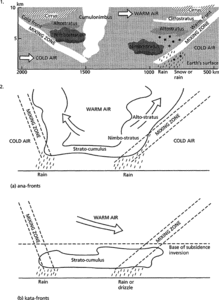Boundary or boundary region separating air masses of different origins and characteristics. Temperature gradients in any horizontal surface are large through the front. Different types of front are distinguished according to the nature of the air masses separated by the front, the direction of the front’s advance, and the stage of development. The term was first devised during the First World War by the Norwegian school of meteorologists (headed by Professor V. Bjerknes). See also anafront; cold front; warm front; katafront; occluded front; polar front.
The border zone between two air masses which contrast, usually in temperature. A warm front marks the leading edge of a sector of warm air; a cold front denotes the influx of cold air. Fronts are intensely baroclinic zones, about 2 000 km long and 2 000 km wide, moving at around 14 km per day. In mid-latitude depressions, fronts develop as part of a horizontal wave of warm air enclosed on two sides by cold air. These frontal wave forms move from west to east in groups known as frontal wave families.
The basic classification into warm fronts, with a slope of 1 in 100, and steeper cold fronts is further divided by the type of air movement at the front. In ana-fronts, the warm sector air is rising, and a succession of cloud types and precipitation results. In kata-fronts, the warm sector air is descending, clouds are few, and precipitation is reduced to a drizzle.

Fronts
- PowerPC
- power reactor
- power routing
- power saving
- power series
- power set
- power((social))
- power spectrum
- power station
- power supply
- power supply rail
- power(symbol: P; unit: watt)
- power transformer
- power transistor
- power up
- power waves
- power winding
- Powhatan
- poxvirus
- Poynings’ Law (1494)
- Poynting, John Henry
- Poynting vector
- Poynting–Robertson effect
- pozzolan
- p-parameter